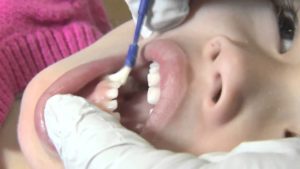Healthy gums and teeth are important to your child's overall health. This is why your child's pediatrician will likely talk with you about good dental habits even before your child's first tooth appears. Part of that discussion will often involve the use or need for fluoride. Fluoride prevents tooth decay and strengthens the enamel of the teeth. It has long been established that children who have the advantages of fluoride and good oral hygiene habits stay free of dental disease. Good oral hygiene habits include proper diet, thorough brushing/flossing, and regular dental visits. The American Academy of Pediatric Dentistry and the American Academy of Pediatrics recommend a child see a pediatric dentist once their first tooth appears for an oral health assessment. Even though pediatricians have discussed oral health with their patients for years, where and when did the practice of applying fluoride varnish become a common occurrence?
In May 2014, the influential U.S. Preventive Services Task Force stated that primary care doctors should start playing a more prominent role in dental care for children The task force is an independent panel of experts that researches and makes recommendations on preventive health care. This recommendation, which was published on May 5, 2014 in the online journal of Pediatrics, is in concert with guidelines issued by the American Dental Association (ADA) and the American Academy of Pediatric Dentistry. Specifically, the task force suggested that primary care physicians prescribe oral fluoride supplementation, such as drops, tablets or lozenges, for children 6 months and older whose water supply doesn't have enough fluoride. In addition, they recommended that infants and children should have fluoride varnish applied to their teeth when baby teeth appear. Many primary care doctors had been following these guidelines for years but the Task Force found that many had not.
In the 2000 “Oral Health in America: A Report of the Surgeon General”, tooth decay was found to be the most common chronic disease in childhood and affects a disproportionate number of low-income and minority children. These vulnerable children have more cavities than other children and have greater difficulty accessing timely and appropriate dental care. Although the American Academy of Pediatric Dentistry recommends the first dental visit occur when the first tooth appears and no later than 12 months of age, children who are at greatest risk for early childhood decay are least likely to have access to this care. The Preventative Task Force also found that almost half of children aged 2 to 11 had cavities in their baby teeth and that 3 out of 4 preschool aged children had not visited a dentist. However, most of these children had been seen by a primary care doctor. Because of this finding, they began recommending that children who had difficulty gaining access to a pediatric dentist receive the application of fluoride varnish at their primary care or pediatrician’s office. They advised that these treatments can be done 2 to 4 times per year, determined by the severity of the child’s risk for cavities. They saw this initiative as a way to help pediatric dentists prevent tooth decay.
Fluoride varnish is a professionally applied, highly concentrated fluoride product that has been widely used in Europe and Canada as a cavity prevention agent for over 30 years. In the past two decades, it has become widely used in the US. Not only can it help prevent cavities, it can reverse early cavities (white spot lesions). Fluoride varnish should be applied whether the local water supply has sufficient fluoride or not.
All pediatric health care providers want their patients to have the best oral health possible. They want these children to have access to quality dental care and preventive services. However, it is unclear why some pediatricians, with patients who have easy access to pediatric dentists and other forms of dental care, many choose to apply fluoride varnish. The hope is that the application of fluoride varnish is a first step in a child’s prevention of decay. Parents look for guidance concerning the usage of fluoride from their pediatrician or primary care doctor, but they should be referring them to a pediatric dentist for the best comprehensive oral care. A pediatric dentist is the expert on a child’s cavity risk assessment and the proper dosage of fluoride supplementation, as well as the frequency of fluoride varnish application.
Is Fluoride Varnish Safe?
Fluoride varnish is safe and, as stated, is used by dentists and physicians all over the world to help prevent tooth decay in children. Only a small amount is used, and hardly any fluoride is swallowed. It is quickly applied and hardens. Then it is brushed off after 4 to 12 hours.

How is Fluoride Varnish Put on the Teeth?
Fluoride varnish is painted on the top and sides of each tooth with a small brush. It is sticky but hardens once it comes in contact with saliva. Your child may feel the hardened varnish with his tongue but will not be able to lick the varnish off. The application is very easy and only takes a minute or two.
How Do I Care for My Child's Teeth After Fluoride Varnish is Applied?
Your child can eat and drink right after the fluoride varnish is applied. However, your child should avoid very hard or very sticky foods, as well as very hot foods or liquids. Do not brush or floss teeth for at least 4 to 6 hours. Your child's pediatric dentist may tell you to wait until the next morning to brush or floss.
The pediatric dentists at Dental Associates of Walpole follow the American Academy of Pediatric Dentistry guidelines regarding fluoride varnish application. Typically, fluoride varnish is applied twice a year, but that frequency can be increased in patients with a higher risk for cavities. If you have any questions regarding fluoride varnish, or any form of fluoride supplementation, please feel free to call our office to get the advice you need.
By Scott Petrie, D.M.D.



